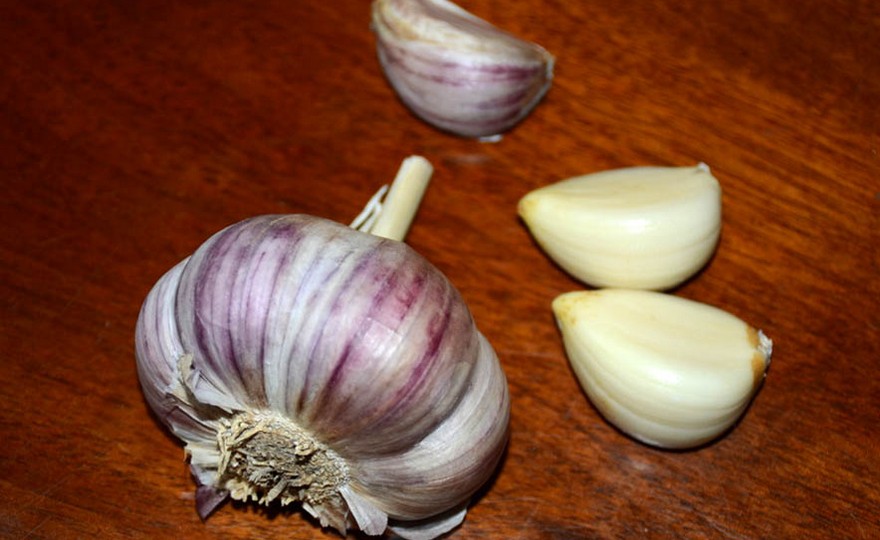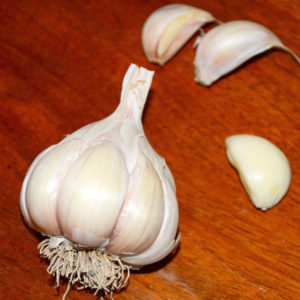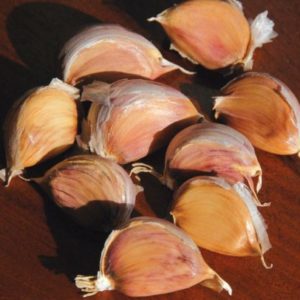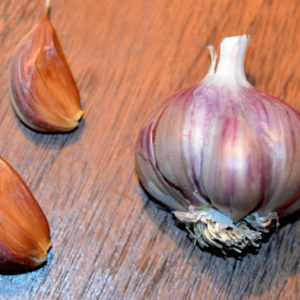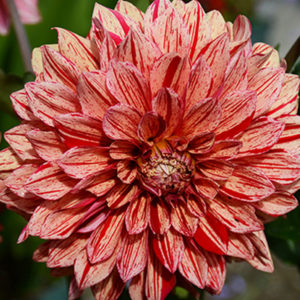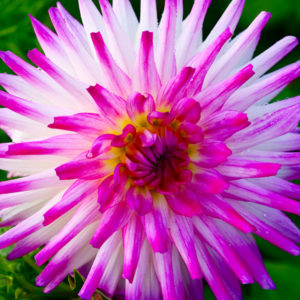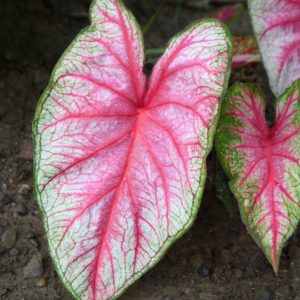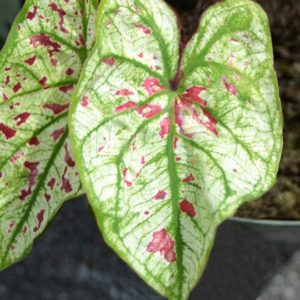Description
 Rocambole Garlic, Spanish Roja
Rocambole Garlic, Spanish Roja
GARLIC, which is a member of the same group of plants as the ONION, has been cultivated for millennia. As a cultivated plant, it is so old that it is difficult to credit a country of origin for this vegetable. Some historians believe that onions and garlic was indigenous to the southwest of Siberia and spread to southern Europe where it became naturalized. It is widely grown in all the Mediterranean countries.
All modern garlic belongs to one of two subspecies: hardneck (ophioscorodon) or softneck (sativum). Hardneck subspecies try to produce flower stalks with small aerial cloves called bulbils. Hardnecks will not produce large bulbs underground unless the flower stalks are removed. There are seven varieties of hardneck garlic: Asiatics, Purple Striped, Glazed Purple Stripe, Marbled Purple Stripe, Porcelain, Turban and Rocambole. Softnecks have lost the ability, for the most part, to produce a flower stalk. However, under certain climatic situations, the bulbs may try to produce a flower stalk known as bolting. There are four varieties of softneck garlic: Artichoke, Turban, Silverskin and Creole.
Of the 10 garlic horticultural groups (Artichoke, Asiatic, Creole, Glazed Purple Stripe, Purple Striped, Marbled Purple Stripe, Porcelain, Rocambole, Silverskin, Turban), the Rocamboles are considered by many to be the best.
There are a number of secondary factors which contribute to the Rocamboles’ outstanding reputation, but the primary factor is their flavor. Raw, the Rocamboles have good, but not overpowering heat, but the heat is matched by the intensity and complexity of the flavor. Rocambole flavor is often described as sweet, and the cloves are incredibly fragrant. It is the fragrance that accentuates the sweet flavor. When raw garlic is called for, as in salad dressings, Rocamboles should be the first choice. When cooked, the heat subsides, but does not disappear and the flavor remains intense and complex. There are a few (very few) cultivars from other garlic horticultural groups that have flavor equal to the Rocamboles, but there are none that surpass the Rocamboles in flavor.
Rocambole bulbs are generally medium sized with 6-11 cloves per bulb. The cloves are medium sized and arranged in a single layer. Despite their smaller size when compared to garlics like the Porcelain group, Rocambole cloves are the easiest of the garlic groups to peel. The clove wrappers loosely fit the cloves. This makes the Rocambole cloves great for cooking.
The most significant negative about the Rocamboles is that they are notoriously poor storers. Usually, they last no more than 3 months, but despite their poor storage capability, they are worth growing.
Another significantly negative factor about Rocamboles is that they are not good for southern climates. They require an extended period of cold exposure (vernalization), and without it they do not develop.
The best known Rocambole garlic cultivar is German White. Throughout the Northern US, German White has been grown for decades. This garlic is a dependable producer with fairly large bulbs and cloves, but it cannot compare to the Rocambole cultivars Harvesting History has in its collections.
Planting and Harvesting Garlic
Garlic is usually planted in October in the north and from November through January in the south. It is important to note that garlic should be planted 4-6 weeks before the ground freezes in order to establish good root growth before winter. If winters are long and temperatures are extreme, then softnecks should be planted in the spring.
Garlic bulbs planted in the fall go through a short, approximately 2-week dormant period, and then roots emerge and leaves sprout. With the onset of winter, the leaves die back and the roots cease to grow. This process is called vernalization. Proper bulbing is a function of adequate growth, vernalization and subsequent growth under longer days. Bulbs planted in the spring must experience some minimal cold treatment in order to insure proper bulbing.
Garlic can be grown in many different types of soil, but the plants prefer a rich moist sandy soil. Turn the soil and add some lime before planting. Break the bulbs apart into individual cloves and plant, root end down, two inches deep, with six inches between cloves in rows twelve inches apart. Mulch immediately. In the spring, apply a 10-10-10 fertilizer and water like any garden green. By summer ease up on the watering. The hardnecks will send up a flower stalk in early June. Approximately one week after the stalk begins to turn woody, starts to uncoil and begins to stand up straight, cut the stalk off ½ inch above the top plant leaf. This will redirect the plant’s energy into bulb production.
When harvest time is approaching, the plants will begin to dry from the bottom leaves up and from the leaf tips inward, one leaf at a time. The plants should be harvested when approximately 40% of the leaves are still green. Bundle in groups of 5-10 and hang inside, out of direct sunlight and where there is good air circulation. Never leave freshly dug bulbs in direct sunlight. The bulbs cure in 3-4 weeks. The bulbs are cured when the neck can be cut one-half inch above the bulb without any evidence of moisture.
Garlics are best stored in netted onion bags at room temperature. Temperatures of 34-44 degrees will induce sprouting. Temperatures in the 30’s are tolerable for table garlic, but planting stock should not be stored long at cold temperatures. Humidity in the 60%-70% is preferable. Rocamboles and Purple Stripes will store for approximately 6 months. Porcelains and Artichokes will store for approximately 8-10 months. Silverskins and Creoles will store for a full year.
Planting Garlic, Shallots, Onions and Elephant Garlic

